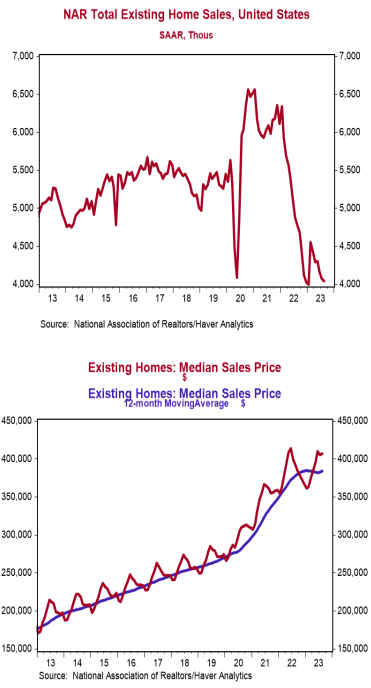- Existing home sales declined 0.7% in August to a 4.040 million annual rate, narrowly lagging the consensus expected 4.100 million. Sales are down 15.3% versus a year ago.
- Sales in August fell in the West and South, remained unchanged in the Northeast, and rose in the Midwest. The drop in August was entirely due to single-family homes. Sales of condos/co-ops rose in August.
- The median price of an existing home rose to $407,100 in August (not seasonally adjusted) and is up 3.9% versus a year ago.
Implications:
There wasn’t much to get excited about in today’s report on existing home sales, which fell for a third consecutive month in August. The housing market facing a series of headwinds, some of them temporary. First, the recent surge in benchmark interest rates like the 10-year Treasury yield has translated into 30-year fixed mortgage rates as well, which are currently hovering above 7.5% for the first time in more than two decades. Assuming a 20% down payment, the rise in mortgage rates since the Federal Reserve began its current tightening cycle in March 2022 amounts to a 41% increase in monthly payments on a new 30-year mortgage for the median existing home. Eventually, the housing market can adapt to these increases, but each surge in rates, like we’ve experienced lately, leads to some indigestion. Meanwhile, home prices appear to be rising again, although modestly, with the median price of an existing home up 3.9% from a year ago. In addition, many existing homeowners are reluctant to sell due to a “mortgage lock-in” phenomenon, after buying or refinancing at much lower rates before 2022. That should limit future existing sales (and inventories). However, a tight inventory of existing homes should prevent a repeat of 2008. Case in point, the months’ supply of homes (how long it would take to sell existing inventory at the current very slow sales pace) was 3.3 in August, well below the benchmark of 5.0 that the National Association of Realtors uses to denote a normal market. Finally, a weakening economy in which the Federal Reserve doesn’t act quickly to cut rates, because of high inflation, could be a headwind for home sales next year. Adding this altogether, expect sales and prices to drag on in the year ahead, with no persistent recovery in existing home sales until at least late 2023 or early 2024. In employment news this morning, initial claims for jobless benefits fell 20,000 last week to 201,000. Meanwhile, continuing claims fell 21,000 to 1.662 million. These figures suggest continued growth in employment in September. Finally on the factory front, the Philadelphia Fed Index, which measures manufacturing sentiment in that region, fell to -13.5 in September from +12.0 in August. The region is home to auto-parts manufacturers who are likely affected by the UAW strike.seasonally adjusted) and is up 3.9% versus a year ago.





